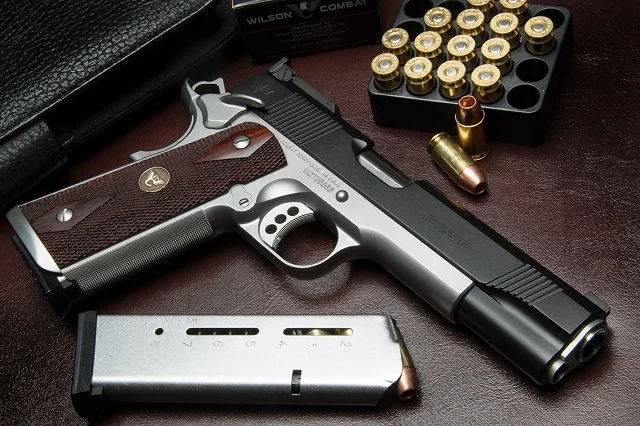1911 vs Beretta M9: Battle Of The Service Guns

Beretta M9 vs 1911: Which Classic Sidearm To Get?
If a person wanted to get a classic service pistol in the safe, two solid choices would be the 1911 vs. M9. Both of these guns are large, powerful, full-size guns that have been carried as duty sidearms by our armed forces and also police officers for many years.
Both could certainly be thought of as being a touch anachronistic, as both are all-steel and both lack striker firing systems. Neither are light, compact, single-stack concealed carry pistols...though there are some people who carry both every day.


Which to get? It partially depends on what you're interested in. Either a Beretta M9 or 1911 is a great pistol and can and will readily serve as a defensive handgun, and each has its benefits and drawbacks. The question is going to be which is right for you.
Old Faithful: The 1911
The 1911...well, what hasn't been said? Two world wars, John Moses Browning and so on and so forth. All the knockdown power of .45 ACP and ergonomics that are second to none.
Then again, the qualities of the 1911 beyond mere pedigree are part of what keep people loving this pistol, which is - make no mistake - certainly an anachronism.
The first thing you'll notice is the ergonomics. The grip angle of about 18 degrees fits most hands very well, and given how the pistol sits in the hand with the weight of the frame and slide, it points very naturally. That makes the 1911 feel intuitive to many shooters, which contributes to accuracy.
Granted, a lot more goes into a pistol being accurate, but how it handles is part of it.
The relatively low bore axis reduces torque on the wrist. The sheer weight of the gun (about 40 ounces unloaded) also helps tame recoil, making the 1911 pistol one of the easiest big-bore handguns to shoot. Granted, you don't shoot long; capacity is 7+1 or 8+1 of .45 ACP, depending on the magazine. It's also a big gun, with Government frames having 5-inch barrel, 8.5-inch overall length, standing 5.5 inches tall but a svelte 1.2 inches wide at the grips.
Operation, as we all know, is single-action, so it's carried cocked and locked with the manual safety engaged or with the hammer down over a live round.
Another benefit is diversity of choice. Whereas the choice used to be almost entirely limited to Colt factory guns or military surplus pistols, today's 1911 buyer has a wealth of options to choose from in terms of features, frame size, caliber and so much more. There truly is a 1911 for just about everyone.

- Overall Length: 8.5"
- Height: 5.5"
- Barrel Length: 5"
- Width: 1.2"
- Weight: 39 oz
The Beretta M9: Wonder Nine Wizardry
The reasons why our government decided on the M9 vs the 1911 are rather long, but the gist of it is that a new service pistol was needed and the decision was made to switch to a NATO caliber, which is 9x19mm. Beretta won out over a few other manufacturers (CZ was still verboten and the Beretta 92 was cheaper that the Sig P226) and became the standard issue sidearm after proving itself in a battery of tests.
The Sig P320 platform was selected as its successor, but since being adopted in the 1980s it served with distinction.
There were some problems with it (there were with the 1911 too) that have been talked about, but it's known to be an accurate, reliable pistol that has saved lives.
The 92FS and/or M9 (it's an M9 if the army issues it; it's a 92FS everywhere else) is a double-single action pistol with a double-stack capacity of 15+1. However, there were a couple different versions, such as the M9A1 (added a rail, more aggressive grip checkering, beveled mag wells, and coated magazines) and the M9A3 (more modular design for customizable sights and other features, dark earth finish, new 17+1 magazines) to be aware of as well.
It's a big gun, being made of an aluminum alloy frame and a steel slide, which means it has some heft. (34 ounces of it.) The controls consist of a slide-mounted decocking safety, which can - in some models - be converted to a decocking lever. Barrel length is 4.9 inches, overall length is 8.5, height is 5 inches and it's 1.5 inches wide. In short, a brick with some bullets inside.
That said, it's a standard by which other high-capacity pistols are judged as the 92 platform has proven itself reliable and accurate in police and military service the whole world over.


Beretta M9 Specs:
- Overall Length: 8.5"
- Height: 5"
- Barrel Length: 4.9"
- Width: 1.5"
- Weight: 34 oz
Why Some People Hate The Beretta M9

While the Beretta M9 is one of the all-time great handguns, there are some things people don't like about it.
First, the grip is rather thick. At 1.5 inches in total width, that's a lot of real estate. Additionally, the trigger reach - the distance between the trigger face and the back of the grip - is almost 3 inches with the double-action trigger setting. Shooters with small hands or short fingers have found the 92FS/M9 difficult to live with.
Then there's the double-action trigger. Double-action shooting requires practice to gain competence, whereas most people find single-action and striker pistols easier to live with. Whereas DA/SA semi-autos were formerly the dominant handgun design, today they're just not as popular.
Granted there are other reasons for that (plastic pistols have a higher profit margin, and if you think that isn't a factor you need to sober up) but it's still the case.
The controls are also awkward, in that many shooters have to manipulate the safety/decocker with the strongside hand. Some people don't, but again, some find them awkward.
Another drawback is that the standard Beretta M9 has steel sights, and if you don't like it, tough; the front sight is part of the slide, so there's no swapping it unless you get the slide dovetailed by a gunsmith. Granted, you can drop some extra cash on one of the models with a Vertec slide, which have dovetailed front sights, which includes the M9A3.
They're also heavy, weighing 40ish ounces loaded, which is a lot to tote around.
Why Some People Don't Like The 1911

Just like the Beretta M9, some people don't like the 1911.
Some people find that grip safeties give them fits. In fairness, this is something that takes a bit of practice; learning to acquire a proper grip on the gun and so on. It isn't mysterious or complicated, but takes some practice.
The manual safety also gives some people a brain hemorrhage. Some people feel a carry gun shouldn't have one, but what's been repeatedly established over the years is that it isn't a hindrance if you actually train with the pistol. It's fine if you don't like or want a manual safety; that's just your preference and that's fine, but it is the case that what a lot of people believe about them is hogwash.
Another drawback is the heft. Standard GI pistols weigh 40 oz unloaded, and have a 5-inch barrel. That's a big, heavy pistol, which is a lot to only have 7+1 or 8+1 on tap of .45 ACP. Granted, 9mm examples bring capacity up to 9+1/10+1, but the same objection still applies.
The controls are inimical to most left-handed shooters, unless you get a model with ambi thumb safeties and swap the magazine release, which some people have been annoyed with.
It also isn't a forgiving platform for the lackadaisical. Best results from a 1911 pistol require keeping it clean and lubricated. Typically, you'll also have to spring for some aftermarket magazines because a lot of factory magazines are trash.
The sights on GI models stink, which is another long-standing complaint. Granted, you can swap 'em...or just buy one that has good sights on it, but then again this is true for a lot of handguns.
Deciding Between The 1911 Vs M9
If you were actually deciding which was better between the 191 vs M9, the truth is that one is going to be better for you and what you want out of a gun. Since it isn't exactly an apples-to-apples choice, each gun is going to suit some people and their desires very well and others not so much.
If you're concerned with capacity, the M9 is the ticket. Granted, there are double-stack 1911s out there (be ready to spend) and if you move down to 9mm rather than .45 ACP, it goes up to 10+1 or 11+1 rounds depending on the magazine. However, some people want the most on-board bullets they can get, and the M9 wins on that score.
You couldn't do much better for a home defense gun.
The 1911 can also be had in multiple frame sizes. The Government frame is most common, but if you're looking at a carry gun then the Commander and Officer frames become viable options though - again - capacity is reduced and .45 is quite lively in a compact gun. So if you like the platform, rather than just the Government-frame gun, there's a lot out there for you.
The M9...is just the M9. It's either what you're looking for or it isn't.
The M9, again, is ENORMOUS. One of the most constant criticisms about it was that shooters with smaller hands weren't able to operate it all that well. An Officer-frame in 9mm, however, can be shot more easily and operated well by shooters with smaller hands.


If you want a project gun, you're going to get more mileage out of a 1911. While aftermarket support for the Beretta 92 is ample, there's a whole lot more for the 1911. The only limits, really, are your imagination or more accurately your budget and skills with small tools.
For carry, the 1911 is actually better despite being taller and heavier. Wait...what? How does that make sense?!
It's the slide, you see.
The M9 is 1.5 inches wide all the way around. While the 1911 is 1.2 inches at the grips, it's 0.9 inches at the slide, making it actually slimmer than some single-stack compact poly striker pistols at least in that dimension, which is why the 1911 is one of the most popular full-size concealed carry pistols. Granted, some people do carry an M9 every day, but more people will have an easier time with a 1911 than the bigger gun.
That is, if you can deal with the decrease in carrying capacity.
As to cost, entry-level 1911 pistols can run anywhere from $400 to $1,000, depending on the maker. Plenty of very, very good examples can be had for around $700 or so, including imports with lots of bells and whistles and US-made GI spec models. Then you get into the custom guns, which go for anywhere from $2,000 to $5,000. The finest of quality demands you pay for it, but you can get a lot of gun for the money.
An M9/92FS has an MSRP of $675, so you can expect to pay about $600 in stores.
Ultimately, it depends on what you want. The 1911, on paper, is great if you want a big gun that can be carried a bit more easily and don't mind the reduced capacity. The M9 is great if you don't mind a big gun or aren't planning to concealed carry it.
That said, talking about it only tells you part of the picture. Get out to a range and try them both out. See which one you like, the one you shoot best. That's the one to acquire.
When you head to the range, use our free 8.5" x 11" shooting target! We'll also be adding more targets to our collection of free printable shooting targets.











